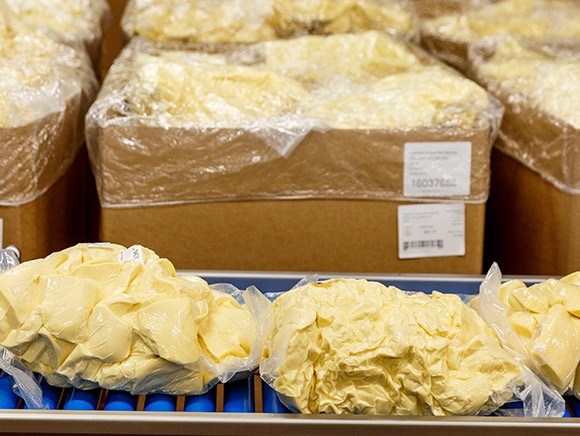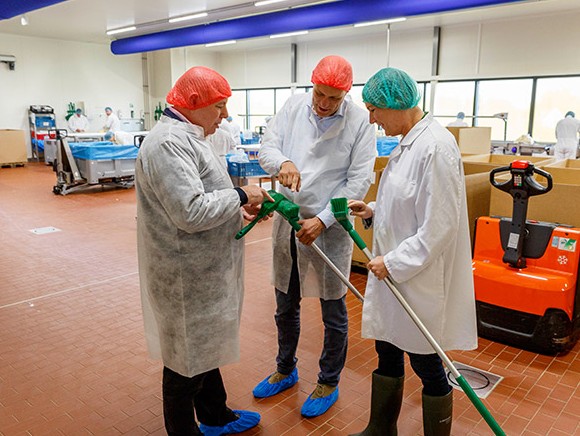
Dutch cheese processor Kaasveredeling Kruijt based in Zegveld has witnessed explosive growth in its production activities, and the facility that was built just three years ago is almost too small already. When production expands so rapidly, it brings with it a greater chance of hygiene failings. Eco2Clean helps Kaasveredeling Kruijt to safeguard and optimise its hygiene.
“The hygiene inspections help to optimise the hygiene”
Kaasveredeling Kruijt is one of the Netherlands’ largest cheese processing companies. It cleans and re-sells side streams of cheese from other processors and is also specialised in the wet derinding of top-quality cheese. “Every year, Kaasveredeling Kruijt handles millions of cheeses which, for various reasons, can no longer be sold without extra processing first,” says Quality Manager Nathalie de Vries. “The majority of those cheeses come from various packing facilities. For example, the two ends of a cheese can’t be used when preparing pre-packed cheese for consumers, and slices or blocks of cheese are often cut to the wrong weight. We give that cheese a second life by making it suitable for use as grated, melted and/or powdered cheese: it becomes cheese for in salads, on pizzas or in crisps or snacks. Because this cheese is ultimately used in consumer end products, it’s extremely important that we supply products that are safe to eat. One of our top priorities is to ensure the microbiological quality of the cheese throughout our processes and that’s where our hygiene partner Eco2Clean comes in.”
Kaasveredeling Kruijt enlisted Eco2Clean’s help in safeguarding hygiene during the production process at around the same time as it opened its new facility. Eco2Clean provides the food industry with cleaning agents, advice and support related to hygiene. “We offer various forms of hygiene care,” says Eco2Clean Director Gert Visscher. “That varies from checking dosages and performing an annual hygiene inspection to completely unburdening the client by taking on full responsibility for the hygiene in their factory. In that case we will contract a cleaning company, supply the cleaning agents, arrange hygiene training sessions and hygiene inspections and analyse the costs and quality of the cleaning activities. Kaasveredeling Kruijt is halfway between those two extremes; it does the cleaning itself, we supply the cleaning agents and organise training and aftercare, including a hygiene audit in line with the company’s own hygiene targets.”
In a cheese processing company like Kaasveredeling Kruijt there is always a risk of contamination, especially in the wet process areas. Jan Vink, Hygiene Advisor and Inspector at Eco2Clean, assessed the production process together with the quality manager and analysed it in terms of hygiene risks and areas for improvement.
“I walk around the factory every two weeks to check the hygiene,” says Nathalie, “but when we did the hygiene inspection together we also looked at other aspects. We looked at the conveyors inside the machine, for example, whereas I normally focus on the surface and the chain links of the belt because they come into contact with the product. We clean very thoroughly at Kaasveredeling Kruijt but there is always room for improvement. This inspection was very valuable for us. It has enabled us to improve the quality of our hygiene and safeguard it even better.”
Photos are taken of any issues that require attention and the findings are always discussed with the cleaning staff themselves. “Many companies develop a kind of blind spot as a result of the daily routine,” comments Jan Vink. “For instance, I always advise people to also crouch down during cleaning; everything might be nice and clean at eye level, but dirt can still have splashed up onto the underside of machinery. Dirty air vents, air conditioning units and the ceiling often also go unnoticed; a great deal of dust can gather there.”

Once the relevant improvements have been made, the cleaning procedures must be adapted accordingly. Vink: “Make your employees more aware of the hygiene risks. I advise managers to check the quality of cleaning every day and to give feedback. That creates awareness and helps to keep everyone alert.” He also recommends that production managers do their rounds of hygiene checks just before production starts. “The spaces and equipment are still damp immediately after they’ve been cleaned. You can only see residual dirt when everything is dry. That takes a little extra time, but interrupting production due to bacterial contamination or – even worse – a recall will ultimately cost you more money.”

“Many companies still haven’t fully realised that they can achieve better hygiene through effective cleaning management. Eco2Clean’s independent hygiene inspections contribute to structural improvements to the hygiene and safeguard the hygiene quality,” concludes Nathalie. “That reduces risks and saves costs.”
Gert Visscher: “In order for the management to be able to make effective decisions based on the quality and costs of cleaning, it’s necessary for them to have up-to-date insight into all aspects and the extent to which they affect one another. That’s why Eco2Clean has integrated the complexity of the cleaning activities into the Hygiene Information Management System (HIMS) software tool.”
Source: ©Roel Dijkstra fotografie